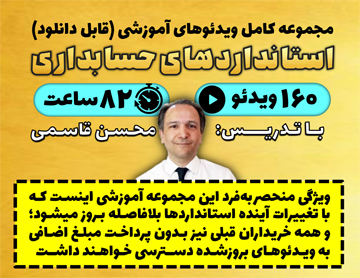داراییهای غیرجاری نگهداری شده برای فروش:
واحد تجاری باید دارایی غیرجاری (یا مجموعهای واحد) را که مبلغ دفتری آن، عمدتاً از طریق فروش و نه استفاده مستمر بازیافت میگردد، به عنوان نگهداری شده برای فروش طبقهبندی کند. (استاندارد حسابداری شماره 31 داراییهای غیرجاری نگهداری شده برای فروش و عملیات متوقف شده (مصوب 1388))
8. طبقهبندی دارایی غیرجاری (یا مجموعه واحد) به عنوان نگهداری شده برای فروش باید تنها پس از احراز شرایط زیر صورت گیرد:
- الف. دارایی غیرجاری (یا مجموعه واحد) برای فروش فوری در وضعیت فعلی آن، فقط بر حسب شرایطی که برای فروش چنین داراییهایی (یا مجموعههای واحد) مرسوم و معمول است، آماده باشد، و
- ب. فروش آن بسیار محتمل باشد.
9. برای آنکه فروش بسیار محتمل باشد، باید تمام شرایط زیر احراز شود:
- الف. سطح مناسبی از مدیریت واحد تجاری متعهد به اجرای طرح فروش دارایی (یا مجموعه واحد) باشد،
- ب. برنامه فعالی برای یافتن خریدار و تکمیل طرح فروش، شروع شده باشد،
- ج. برای فروش دارایی (یا مجموعه واحد) به قیمتی منطقی نسبت به ارزش روز آن، بازاریابی مؤثری انجام شده باشد،
- د. انتظار رود که شرایط تکمیل فروش طی یکسال از تاریخ طبقهبندی، به استثنای آنچه در بند 10 مجاز شمرده شده است، احراز گردد، و
- ﻫ. اقدامات لازم برای تکمیل طرح فروش نشان دهد که انجام تغییرات بااهمیت یا توقف آن بعید است.
10. شرایط و رویدادها ممکن است دوره تکمیل فروش را از یک سال طولانیتر کند. اگر تأخیر از شرایط و رویدادهایی ناشی شود که از کنترل واحد تجاری خارج است و شواهد کافی وجود داشته باشد که واحد تجاری به تعهدات خود نسبت به طرح فروش داراییها پایبند است، طولانیتر شدن دوره فروش نمیتواند از طبقهبندی یک دارایی غیر جاری (یا مجموعهای واحد) به عنوان نگهداری شده برای فروش جلوگیری نماید. این مورد در صورتی روی خواهد داد که شرایط مندرج در پیوست شماره 1 احراز شود.
11. معاملات فروش شامل معاوضه داراییهای غیرجاری با یکدیگر نیز میشود به شرطی که این معاوضه طبق استاندارد حسابداری شماره 11 با عنوان داراییهای ثابت مشهود، دارای محتوای تجاری باشد.
12. چنانچه واحد تجاری، یك دارایی غیرجاری (یا مجموعهای واحد) را صرفاً به قصد واگذاری تحصیل نماید، در تاریخ تحصیل، آن دارایی غیرجاری را فقط در صورتی باید بهعنوان نگهداری شده برای فروش طبقهبندی کند که الزام یکسال مندرج در بند 9 (به استثنای آنچه در بند 10 مجاز شمرده شده است) رعایت شود و احراز هر گونه معیار دیگر مندرج در بندهای 8 و 9 که در تاریخ تحصیل محقق نشده باشد، در یک دوره کوتاهمدت بعد از تحصیل (معمولاً طی مدت 3 ماه) بسیار محتمل باشد.
13. در صورتی که معیارهای بندهای 8 و 9 بعد از تاریخ ترازنامه احراز شود واحد تجاری نباید در صورتهای مالی، داراییهای غیرجاری (یا مجموعههای واحد) را به عنوان نگهداری شده برای فروش طبقهبندی کند. با این وجود، هنگامی که این معیارها بعد از تاریخ ترازنامه، اما قبل از تأیید صورتهای مالی احراز شود واحد تجاری باید اطلاعات تعیین شده در بند 40 را در یادداشتهای توضیحی افشا کند. (همان منبع)
Non‑current asset as held for sale
an entity shall classify a non‑current asset (or disposal group) as held for sale if its carrying amount will be recovered principally through a sale transaction rather than through continuing use - IFRS 5 Non-current Assets Held for Sale and Discontinued Operations
7 | For this to be the case, the asset (or disposal group) must be available for immediate sale in its present condition subject only to terms that are usual and customary for sales of such assets (or disposal groups) and its sale must be highly probable. |
8 | For the sale to be highly probable, the appropriate level of management must be committed to a plan to sell the asset (or disposal group), and an active programme to locate a buyer and complete the plan must have been initiated. Further, the asset (or disposal group) must be actively marketed for sale at a price that is reasonable in relation to its current fair value. In addition, the sale should be expected to qualify for recognition as a completed sale within one year from the date of classification, except as permitted by paragraph 9, and actions required to complete the plan should indicate that it is unlikely that significant changes to the plan will be made or that the plan will be withdrawn. The probability of shareholders’ approval (if required in the jurisdiction) should be considered as part of the assessment of whether the sale is highly probable. |
8A | An entity that is committed to a sale plan involving loss of control of a subsidiary shall classify all the assets and liabilities of that subsidiary as held for sale when the criteria set out in paragraphs 6–8 are met, regardless of whether the entity will retain a non‑controlling interest in its former subsidiary after the sale. |
9 | Events or circumstances may extend the period to complete the sale beyond one year. An extension of the period required to complete a sale does not preclude an asset (or disposal group) from being classified as held for sale if the delay is caused by events or circumstances beyond the entity’s control and there is sufficient evidence that the entity remains committed to its plan to sell the asset (or disposal group). This will be the case when the criteria in Appendix B are met. |
10 | Sale transactions include exchanges of non‑current assets for other non‑current assets when the exchange has commercial substance in accordance with IAS 16 Property, Plant and Equipment. |
11 | When an entity acquires a non‑current asset (or disposal group) exclusively with a view to its subsequent disposal, it shall classify the non‑current asset (or disposal group) as held for sale at the acquisition date only if the one‑year requirement in paragraph 8 is met (except as permitted by paragraph 9) and it is highly probable that any other criteria in paragraphs 7 and 8 that are not met at that date will be met within a short period following the acquisition (usually within three months). |
12 | If the criteria in paragraphs 7 and 8 are met after the reporting period, an entity shall not classify a non‑current asset (or disposal group) as held for sale in those financial statements when issued. However, when those criteria are met after the reporting period but before the authorisation of the financial statements for issue, the entity shall disclose the information specified in paragraph 41(a), (b) and (d) in the notes. |
12A | A non‑current asset (or disposal group) is classified as held for distribution to owners when the entity is committed to distribute the asset (or disposal group) to the owners. For this to be the case, the assets must be available for immediate distribution in their present condition and the distribution must be highly probable. For the distribution to be highly probable, actions to complete the distribution must have been initiated and should be expected to be completed within one year from the date of classification. Actions required to complete the distribution should indicate that it is unlikely that significant changes to the distribution will be made or that the distribution will be withdrawn. The probability of shareholders’ approval (if required in the jurisdiction) should be considered as part of the assessment of whether the distribution is highly probable. |





دیدگاه خود را بنویسید